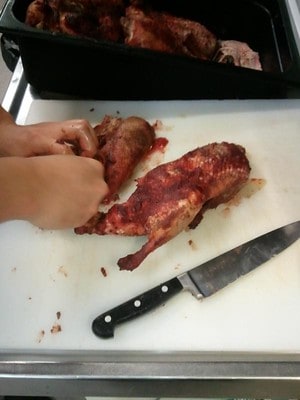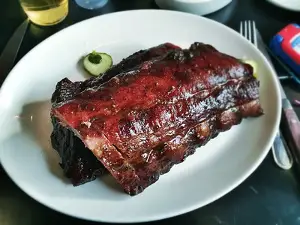
Today, as we think about your dog, I want to talk about duck bones.
And whether they are a safe food to feed your dog.
Now duck bones might seem to be a bit of a strange topic to write an article about because , forget about dogs, how many people eat duck?!
I mean, it can’t be that many people that eat it, can it?
Which is very true when you compare it to chicken for instance.
But, I can think of a couple of scenarios involving duck bones and dogs.
The first one is when your dog turns opportunistic thief and snacks on the carcass from that lovely Peking duck you ordered from your local Chinese restaurant.
And secondly, those of you who take your dogs for walks in the countryside, might stumble on the carcass of a duck.
But, for starters, I want to suggest two reasons that duck bones might not be a good idea to feed your dog.
Two reasons why dogs should not eat duck bones
Duck bones are too small
Ducks are, as we all know, about the same size as a chicken give or take.
Which means that most of the bones in a duck are too small for dogs.
And by that I mean they are choking hazards.
If you think about the size of a duck’s bone compared to the size of a dog’s mouth of a dog, many dogs will try and eat the bone without chewing it properly.
And as those fragments are swallowed, they might choke the dog.
Now for smaller dogs (such as many companion breeds) duck bones would be an ideal size because their mouths are a lot smaller.
They would try to gnaw these bones and chew them properly- you would hope!
Cooked duck bones are too brittle
I am thinking at this moment that your dog has eaten the remains of your Peking duck from your Chinese take out.
The trouble is that cooked bones are hard and brittle compared to their raw equivalents.
All of that flexibility and softness in a raw bone has been “baked out” of them.
And cooked bones aren’t great for dogs.
As when cooked bones are broken up as a dog chews them they are far more likely to break up and splinter into sharp pieces.
As well as being a choking hazard, these splinters might be sharp enough to cut the inside of your dog’s intestinal tract..
Of course, if you have a dog who has snacked on a duck carcass whilst out on a walk, at least the bones will be raw…
Duck bones that are safe
Apart from being raw, there are some bones within a duck that are safer for a dog to eat than others.
And this goes for the bones from any animal.
The safest bones, as far as your dog is concerned, within any animal are weight bearing bones- which are the leg bones.
Weight bearing bones are denser because they are being put to use more than other bones in a body.
They need to be stronger because they are carrying the weight of an animal.
And denser bones are less likely to be brittle and are therefore safer for a dog to chew on…
Do you begin to see that there is an emerging theme of “brittle” here?!
So where does that leave the other bones in a duck’s body?
We will talk about that in the next section.
Duck neck vs duck wings vs duck feet? Which are the best bones?
Raw duck necks, wings and feet are all popular dogs foods available to buy from many different sites on the Internet.
But just because they are for sale doesn’t mean that they are safe for your dog.
But which one of these is the safest choice for your dog?
My answer would be- none.
They are all as safe or unsafe as each other.
After all, they are all a combination of a bit of duck meat which binds a whole collection of (small) bones together.
The onus is on you here..
How well do you know your dog?
Will your dog take their time and gnaw at these bones or will the bones be swallowed in an instant.
Dog’s that like to take their time with a bone will be a lot safer than those dogs whose food is here one minute and gone the next.
As I said a few moments ago, any duck bone that you give your dog will almost certainly have a bit of meat on it.
But how does duck meat compare to other meats in terms of it’s nutrition?
In the next section I compare duck with chicken.
Duck vs chicken- nutrition
Since we are talking about duck bones, in this comparison I will use the nutrition data for raw duck and raw chicken.
All the data for duck came from here and for chicken it came from here.
| 100 g serving | Duck | Chicken |
| Calories | 211 | 234 |
| Fat | 15 g | 17 g |
| Sodium | 56 mg | 45 mg |
| Protein | 17 g | 19 g |
A quick glance at these figures shows us that there is not a lot of difference between these two meats.
Duck is a slighter leaner meat with about 10% less calories (211 vs 234) than chicken and slightly less fat (15 g vs 17 g) and protein (17 g vs 19 g) than chicken.
But in the big scheme of things those differences are negligible.
Next up we can compare the main vitamins and minerals
| 100 g serving | Duck | Chicken |
| Thiamin (B1) | .351 mg | .064 mg |
| Vitamin B6 | .53 mg | .36 mg |
| Niacin (B3) | 3.317 mg | 7.27 mg |
| Copper | .312 mg | .050 mg |
| Selenium | 12.8 mg | 14.6 mg |
Both the vitamins and minerals are measured in micrograms, which is a very small unit of measure.
Remember that there are one thousand micrograms to a gram.
Duck has nearly six times as much Thiamin than chicken (.351 mg vs .064 mg) and more vitamin B6 (.53 mg vs .36 mg)
However, chicken does contain more than double the amount of vitamin B3 than duck does (7.27 mg vs 3.317 mg.)
Now all of this might be pretty meaningless unless we know how all of these B vitamins help our dogs.
And it turns out that B vitamins play an important role when it comes to turning food into energy.
Duck is a much better source of copper than chicken.
Copper is a well known mineral but few people know the role that it plays in the human body: or a dog’s body come to that!
Copper is essential for the creation of red blood cells.
You know- they are the things that carry oxygen around the body!
Chicken beats duck when it comes to selenium (14.6 mg vs 12.8 mg) which really is a mineral that very few people know about.
And its role? Little known but it has a hand in a few very important processes- such metabolism and boosting our immune system.
And I think that we can all agree that duck did very well didn’t ?
So having given you a whirlwind nutrition tour to see how duck shapes up against its close neighbour chicken, next my attention will focus on some issues to wary of when it comes to feeding your dog raw duck.
Is it dangerous to feed raw duck meat to a dog?
Now, in fairness to duck, this is an issue with all raw meats.
You see any raw meat might contain some bacteria or parasites that could potentially harm your dog.
Duck is a “poultry” and it is these meats and eggs (chickens, turkeys, ducks or geese) which are particularly dangerous.
Salmonella is a big bacteria for any poultry and up to 1.35 million people in the US are infected with it every year and of those 420 die.
Part of the problem is that people are far more aware of the dangers posed by raw chicken than they are by the danger of raw or undercooked duck.
And raw duck might be particularly susceptible to another bacteria, called campylobacter.
And this bacteria is just as dangerous as salmonella and it will potentially make your dog very sick.
Symptoms include very watery diarrhea and stomach or abdominal pain.
Can dogs eat duck bones?
I think for most dogs, duck bones are too small to be ideal.
Weight bearing bones from larger animals (such as a pork or beef bone) might be better and provide your dog with an opportunity to gnaw and chew on a bone instead of wolfing down a smaller bone in seconds.
However, looking at the opportunities for buying duck’s necks, duck’s feet and duck’s wings online, it is obvious that they are a popular choice with dog owners.
If you do feed your dog duck bones just make sure to feed them raw and to never let your dog chew these smaller bones unsupervised.
After all, if a duck bone goes down the wrong way, you want to be close by in order to help your dog out.






